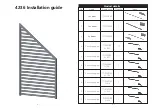
8 / 46
51376-010 GB/2020-10
1
electronic GmbH & Co. KG • Heinrichstraße 3-4 • 12207 Berlin • Deutschland • info@bandelin.com
1.4
Technical data
SONOPULS ultrasonic homogenisers are interference-free and marked with a CE.
Safety: EN 61010-1,
EMC: EN 61326-1
1.4.1
Ultrasonic generator (GM)
Mains supply:
230 V~ (± 10 %) 50/60 Hz, alternatively 115 V~ (± 10 %)
50/60 Hz, cable length 2 m
Protection class:
I
Ultrasonic frequency:
20 kHz ± 500 Hz
Frequency control
/1
:
Automatic, resonance frequency search
Time setting range:
0:00:01 – 9:59:59 [h:mm:ss] or continuous operation
Ultrasound operating mode:
Pulsating or continuous
Pulsation time ON (t
E
):
0.2 - 600 s - (see chapter 3.2.2)
Pulsation time OFF (t
A
):
0.3 - 600 s - (see chapter 3.2.2)
Ultrasound control:
Amplitude or power - (see chapter 3.2.4)
Amplitude setting range:
10 - 100 % in 1 % steps
Amplitude display / power display:
Presetting and progress bars
Energy display:
kJ
Temperature sensor:
optional (TM 50 or TM 100)
Temperature display:
-10 – 120 °C
Program storage locations:
9
Operating elements:
Membrane key
Operating data display:
LCD graphic display, illuminated
Remote control (turning on/o
ff
):
Button on the ultrasonic converter, potential-free contact,
foot switch TS 8 (optional)
Interface: RS
232
Degree of protection:
IP 30 according to DIN EN 60529
Device-speci
fi
c:
Generator
GM 4200
GM 4400
Power
/2
, maximum
50/100/200 W
/3
200/400 W
3
Ultrasonic frequency
20 kHz
Power setting range
30 - 150 W
60 - 300 W
Weight (approx.)
3.2 kg
3.6 kg
Exterior dimensions (l × w × h)
335 × 150 × 230 mm
/1 Frequency
control:
The ultrasonic generator has an automatic search feature for resonance frequency and rate adaptation while in operation. Causes for
a change in the resonance frequency are, for example, a warming of the ultrasonic converter and the probes, a change in the acoustic
load due to changes in viscosity, and even the mounting of another probe. A frequency drift during operation is corrected by the automatic
frequency control. The optimum working frequency is sought using the resonance frequency search, e.g. after a change in probe.
/2 Power:
In the case of amplitude control, the ultrasonic power that is needed for the desired probe amplitude is dependent on the viscosity of the
medium. In order to prevent damage to the ultrasonic generator and converter, the power is limited to the maximum-allowed peak value.
In the case of highly viscous media, this can also result in the desired amplitude not always being reached.
/3 depending on the connected ultrasonic converter
Summary of Contents for Sonoplus HD4050
Page 44: ......









































